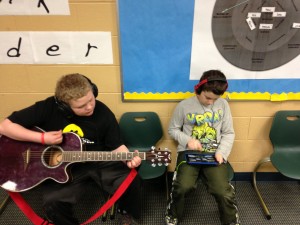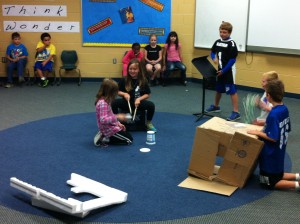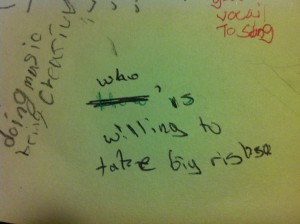As I sit in front of my computer the night before the first day of school begins for me in a new school district, I find myself reflecting upon last weeks new teacher orientation (even though this is going to be my 7th year teaching) and the charge I have anticipating an awesome year. I have joined a district that prides itself as being a leader in educational innovation. We recognize that the world is changing around us and we must evolve and change our teaching to support new ways of learning. I have joined a group of teacher leaders who have a have a growth mindset. I believe, growing from the writings of Margaret Wheatley, that we need to approach a new situation with the willingness to be disturbed. This fosters growth.
The superintendent of Bloomfield Hills Schools, Robert Glass (@glasr333), opened the new teacher orientation with a talk about our mission statement, core values, and strategic instructional goals. I was delighted to hear these 10 guiding principles, from which the district frames the learning experience.
1) The curriculum makes time for depth by thoughtfully managing the number of standards (‘less is more’ concept) I choose to schedule Informances because of this guiding principal. Musicians invite the audience into the processes of musicianship by performing the music that they are exploring in class at that time. They explain the depth of understanding as they perform their pieces, mostly originally composed music, to their parents, peers and community. Less is more.
2) Content knowledge, while important, ceases to be the primary learning outcome, becoming the vehicle to support higher levels of thinking (application, analysis, synthesis, evaluation, creation.) The dates of the musical periods and labels musicians put on expression, like pianissimo and dolce are important content knowledge, on a need-to-know basis. I support musicians using the organization of sound and silence to express, be songwriters, create with passion and purpose. Create.
3) Deep student ownership and control of learning. Teaching shifts to facilitation. Designing projects where musicians can create divergent musical solutions enables autonomy. Facilitating a true music workshop caters to this shift. When musicians are working in “bands” or composition groups, I am able to conference with individual musicians or the entire group at a time. This allows for musicians to create at their Zone of Proximal development until they encounter a time where they seek out the help of a more experienced musician (you) which makes the dialogue more meaningful. Make the shift.
4) Strong, caring relationships and very high levels of collaboration among/between staff and students. The International Baccalaureate Learner Profile is a great place to begin to build relationships with your students. Show them you want to understand how they see themselves and that you care, They matter. I have been told by some very wise friends that ‘They wont remember exactly what you taught them, what they will remember is how you made them feel.’ Bring out the best in your students. Focus on what they can do rather than on all the things they can’t do. Build those relationships.
The first time I got together with the staff at West Hills Middle School, I immediately felt the collaborative culture. I met with the 4/5 grade teachers to discuss the big ideas and concepts that run through their curriculums and how we could support the learners with different experiences. I had no trouble finding a teacher to collaborate with for this season of Rock Our World. Share, Learn, Grow.
5) A culture that embraces risk-taking in the learning process believing that sometimes more is learned from failure than success. Rob Glass spoke about reframing failure. It’s not a failure, it’s an iteration. I create an environment where it is okay to make mistakes with sound, sometimes our mistakes become the inspiration for the next iteration. When this is a part of your classroom culture, you will never hear “am I done?” because there is always another iteration. This is where my piece is today, and sometimes that has to be the iteration that is submitted for world review, but as we become more experienced, our music will be different. Take risks, with your students.
6) Project-based/Inquiry-based interdisciplinary learning boosts critical thinking and creativity by allowing students to frame problems and construct their own solutions. I plan to take the ‘projects’ a step further this year. I have always designed open-ended problems that musicians have created musical solutions for such as improvisations, compositions, arrangements, videos, cover song, etc. We have shared these pieces on our class website, YouTube, SoundCloud, and on my blog. This year, after having dinner with Kevin Honeycutt, I plan to add a purpose to the projects. I have already contacted David Dubois, a teacher in Grand Rapids, to collaborate on ‘Music to save Music’. A project I will approach my students with to create original music to bring awareness to music programs that are being cut. We will submit our original music to iTunes and all of the proceeds will go to a cause of their choice. Construct solutions with purpose.
7) Learners are connected to the world outside the school. See Rock Our World post.
8) Engagement in meaningful work that increases learner passion and motivation. This speaks to all of the above Guiding Principles. Learning trends are shifting to more differentiated learning paths. Divergency in showing ones understanding supports the individual learners’ passion and motivation. When exploring a concept such as tension and release in music, do you allow any piece of music that shows this understanding? Musicians connect to genre and instrumentation. The shared understanding that any kind of musical creation will be acceptable supports agency and feeds musicians’ passion and motivation. Make divergency a norm.
9) Technology tools are readily available and easily accessible to support personalization. I have 8 iPad minis that are out on my desk at all times. There are not necessarily iPad projects, they are available for anyone to use at any time. Kevin Honeycutt talks about ‘cognitive blisters’ which prevent kids from learning. Are there ‘music blisters’? I call them hurdles. I believe that for some musicians, standard notation is a hurdle. We all have awesome music in our heads that we want to share with others. If I were to ask you to create a piece of music, but only through standard notation, the result probably won’t be as complex as the music you have in your inner ear. When musicians use technology to support their music making, they can create a very close arrangement to the music in their head. Not all musicians use technology and that is okay. The ones who want to, or need to, can. Have technology available.
10) Staff share a commitment to a small set of clearly understood annually identified, generally agreed-upon, non-negotiable instructional goals. This is a Guiding Principal that I have no experience with, yet. I interpret this as making the commitment to be the best teacher I can be, and I will be held accountable for it. I think that this is also a commitment to a growth mindset.
These Guiding Principles are a fantastic frame for the experiences you design for the learners who will be in your classrooms starting tomorrow and for the rest of the year. I am lucky to be a part of a district that are committed to these principles. By working together and being committed to a clearly understood set of shared goals, we will create a school district that truly, “…enables our learners to be architects of their own futures” ~Rob Glass








